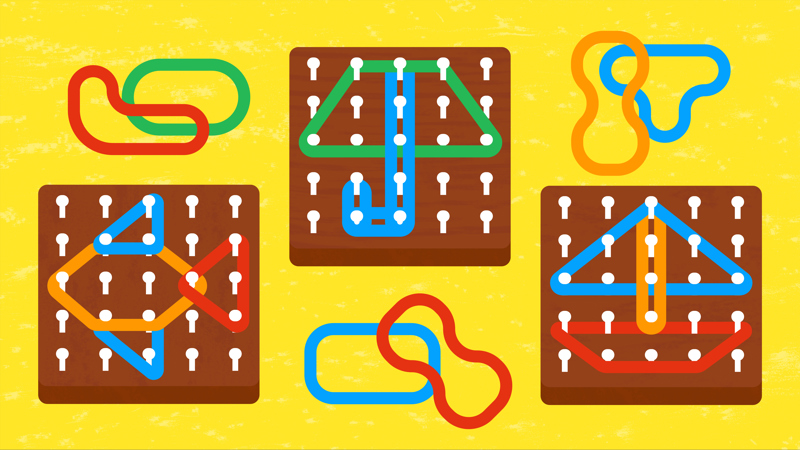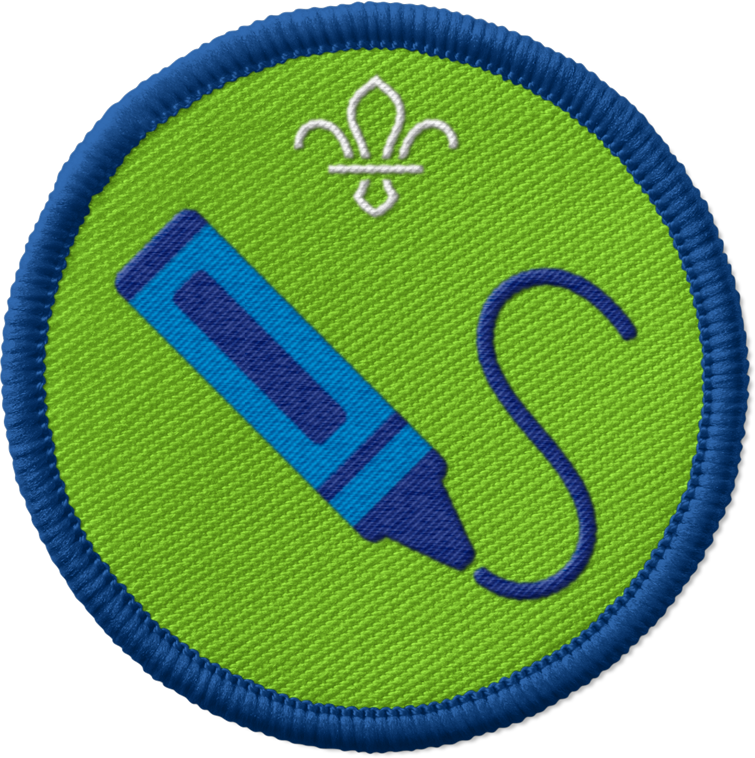
Create your own geoboard
You’ll need
- Elastic bands
- Hammer
- Soft wood
- Protective gloves
- Flat-topped nails
Before you begin
- Get in touch with everyone’s parent or carer and tell them that their young person will be using a hammer and nails in this session. Make sure they know that it’s best if everyone wears closed toe shoes.
- Make sure you’ll have enough adults to supervise and keep people safe. You’ll need plenty of helpers when you get stuck into Hammer and nails. You could invite parents and carers, other volunteers, and Young Leaders to help with this session.
- Make sure that you’re using soft wood so people don’t have to hammer the nails very hard. Choose small nails that don’t travel all the way through the wood.
Story time
- Everyone should sit in a circle on the floor.
- Someone should read Bampy’s Knitting Circle by Jess Connett, an adult could help with reading the story.
- Once everyone’s heard the story, they should take some time to reflect on it as a group. We’ve included some questions to help you reflect in the pink box below.
Bampy was sitting in his chair, knitting very fast. He loved to knit. Sometimes the long roll of wool went bouncing off his knees and onto the floor.
His granddaughter Zennor would pick it up, and then help count the rows of stitches to make sure everything stayed nice and neat.
‘Would you like to meet my friends from my knitting group, Zennor?’ Bampy asked one day.
‘Yes please!’ said Zennor. She liked getting out of the house and meeting new people.
They packed Bampy’s knitting into a bag, and then got the bus into town.
The knitting group met in a café on the main road. Through the window, some friendly people waved at Bampy and Zennor.
‘Hello, Zennor! Nice to see you today,’ said a lady. She showed them some space on the squashy sofa where they could sit down.
‘My name is Nirm. Your grandad has told me all about you!’
‘Hello, Nirm,’ said Zennor. ‘Hello, everyone who likes knitting!’
Each person in the group had a pair of long grey knitting needles like Bampy’s, and each person had a ball of wool.
But the strange thing was that no two people were knitting the same thing.
Bampy was working on a jumper for Zennor. It was going to be her birthday present. It was red – her favourite colour.
Nirm was making a scarf. It was stripey. ‘It’s my favourite football team,’ she told Zennor. ‘I’m going to wear it when I watch a game.’
Tony was knitting tiny hats for babies in hospital. The hats would keep them nice and warm.
Tallulah was making fluffy pom-poms to brighten up their bedroom.
Bertha was making squares in clever patterns, to turn into a special blanket.
‘I didn’t know you could do so many things with a ball of wool and two little sticks!’ said Zennor.
Bampy said she was right. ‘And that’s why I like knitting,’ he said. ‘Everyone can start with the same materials, but what we make at the end is our choice.
‘It doesn’t matter what you make, or how it looks compared to someone else’s, as long as you have a go.’
By Jess Connett
Hammer and nails
- The person leading the activity should show everyone how to hammer small nails into soft wood.
- Everyone should find a partner.
- Each pair should talk about the things people must do when hammering nails to make sure they don’t hurt themselves.
- Everyone should get into small groups.
- Each small group should sit on the floor with one block of wood, a hammer, and some small nails.
Only give each group the equipment to make one geoboard. It’s best for each group to work on one geoboard at a time, so that helpers can support everyone with their creations and help them to stay safe.
- Everyone should put their protective gloves on. When they’re ready, everyone should take it in turns to hammer a nail into the wood.
An adult may need to help start off each nail. Make sure the nails are evenly spread out across the geoboard.
- Once everyone’s had a turn and the geoboards are finished, everyone should work together to tidy away all of the equipment.
- Everyone should take some time to reflect on the activity as a group.
We’ve included some questions to help you reflect in the pink box below.
Elastic fantastic
- An adult should check that all of the nails on each geoboard are secure and safe.
- Everyone should take it in turns to use elastic bands to make a shape on their group’s geoboard.
If anyone’s struggling to think of a shape to make, encourage them to think of something they love – they could have a go at making that.
- Once they’ve finished their shape, each person should explain the pattern they’ve made and how they felt about the task.
- Once everyone’s had a turn, they should take some time to reflect as a group.
We’ve included some questions to help you reflect in the pink box below.
Reflection
In this activity, everyone developed their basic DIY skills and created a piece of art.
Why is it helpful to know how to use a hammer and nails safely? People might think about how they’ll be able to fix things when they break or how being able to use a hammer and nails makes them feel more confident about building things.
How can people make sure they use DIY equipment like hammers and nails in a safe and responsible way? People might suggest concentrating on what they’re doing, asking an adult for help, or wearing the right protective clothing.
You can talk about the reflection questions below throughout the session or at the end.
Story time
- How do people feel when they make things with their hands?
- What did people enjoy about the story?
Hammer and nails
- How did everyone stay safe during this activity?
- How did people feel once they’d made their geoboard?
Elastic fantastic
- Was it hard to place the elastic bands around the nails on the board?
- This activity helped people to develop their fine motor skills and hand-eye coordination. Does anyone know what this means? People might know that fine motor skills help them to use the little muscles in their hands and wrists to make small movements. Hand-eye coordination is all about someone’s brain using what they can see to move their hands in the right way, for example, when someone catches a ball.
Safety
All activities must be safely managed. You must complete a thorough risk assessment and take appropriate steps to reduce risk. Use the safety checklist to help you plan and risk assess your activity. Always get approval for the activity, and have suitable supervision and an InTouch process.
- Sharp objects
Teach young people how to use sharp objects safely. Supervise them appropriately throughout. Store all sharp objects securely, out of the reach of young people.
- Hand and electric tools
Inspect tools for any damage before each use. An adult should supervise people using tools, and people should follow instructions on how to use them correctly and safely. Tools should be properly maintained and kept sharp.
Use an appropriate surface and make sure materials are stable and supported when you’re working on them. You should cut and drill away from the body and in an area clear of other people. Be extra cautious of trailing cables and water when using electric tools. Always use a cordless tool if one’s available.
- It’s up to you how big your geoboards are and how many nails they have in them. It’s good to make sure that everyone has a turn at hammering a nail into the wood.
- Choose the right size nails for your group.
Make it accessible
All Scout activities should be inclusive and accessible.
Why not have a go at some other crafts with your friends or the people you live with? You could try some other crafts that develop fine motor skills like sewing, weaving, or lacing.
You could choose one person in every group to be the health and safety lead. They could make sure that everyone is using the equipment safely.
Get everyone involved helping other people in their group and tidying up the equipment at the end – it’s good to share the responsibility.
